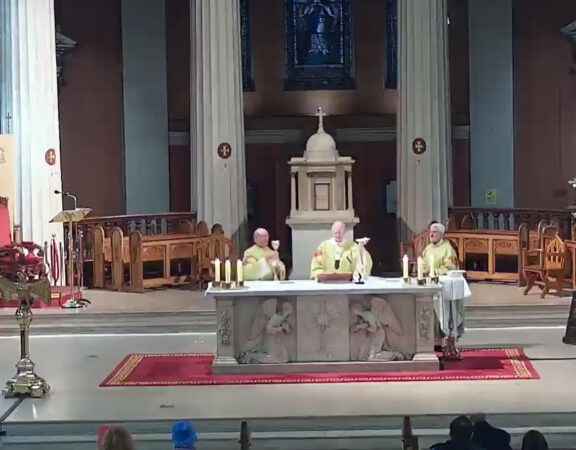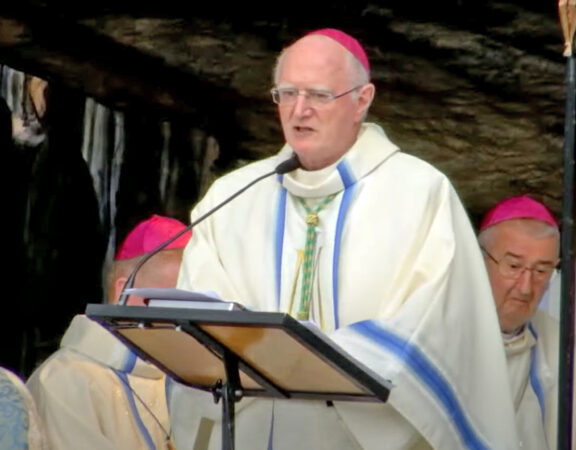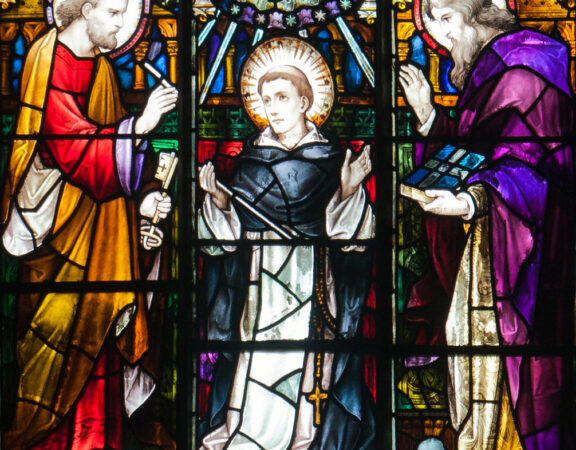OFFICIAL OPENING OF MALAHIDE PARISH PASTORAL CENTRE
Homily Notes of Most Rev. Diarmuid Martin Archbishop of Dublin
Saint Sylvester’s Church, Malahide, 16th November 2013
As I prepared to come here this afternoon, I began thinking of the evolution of the plans to build the Roman Catholic Cathedral in Liverpool. By the 1930’s, Liverpool, the largest Catholic diocese in Great Britain, still had no Cathedral. It was something which both bishops and people felt as incongruous and they longed for a building which would mark the presence and the strength of the Catholic community within their city.
In 1933 a new archbishop rose to the occasion and promised that the people would see “a Cathedral in our time”. But this was not to be. The plans were too elaborate; the economic situation of the city which declined with the Second World War and the harsh economic aftermath meant that the planned building remained for years unfinished apart from the crypt. The dream of a “Cathedral in our times” proved not to be feasible.
Another new Archbishop in the 1960’s, decided to take up the project but with a revised plan. His idea was to build “a Cathedral for our times”, not so much a demonstration which marked the presence and the strength of the Catholic community, but a Cathedral shaped by contemporary architecture and the use of the building materials of the time. His aim was to show that the Church must be present in society in different ways in different times. His hope was that a leaner but more striking modern building would witness to the fact that the Christian faith does not belong to a past era but to the world and the thought and the ideas and the materials of any time. His aim was also to leave for future generations a memory of the culture of that moment which would still have something to say to the generations which were to follow.
As I prepared to come here this morning, I thought also of the journey that my predecessor Archbishop Daniel Murray made to Malahide in 1844 to open this Church of Saint Sylvester in a changing Malahide. It was not as easy a journey as today and he was already 76 years of age. They were difficult times and the Great Famine was already lurking in the shadows. In the short period after Catholic Emancipation in 1829, Archbishop Murray had watched the landscape of Catholic Dublin change and he had opened many of the striking Churches that still adorn the city centre of Dublin and in the rural towns especially in county Wicklow. He was associated with the establishment of Irish Religious Orders and with bringing Religious Orders from continental Europe to renew the Irish Church. He was renowned as a friend of the poor and he established many of the institutions which turned their attention to groups which were the totally neglected of his time: the blind, the deaf, the orphans and the abandoned. The 1840’s were difficult times, but they were times when the Catholic community in the Archdiocese of Dublin was renewing itself.
The Church changes with the times. Indeed the Church must change with the times. The church adapts to the times and is called to witness to how the message of Jesus Christ is relevant and necessary in every stage of changing history. One of the striking aspects of the new parish pastoral centre is the attentive way in which it has been seamlessly integrated with the existing Church building and landscape. This is not just the fruit of architectural best-practice; it is also a symbol of the manner in which the Church is called, generation after generation, to integrate the best of the past with the aspirations of the day and of tomorrow.
I sincerely congratulate all those who had the idea of establishing this parish pastoral centre: those who planned it, these who financed it, the parish pastoral council and the priests of this and the neighbouring parish grouping, and those who had the determination to ensure that this model of Church complex for our times could be completed on time.
While singling out anyone is dangerous, I would like to say a special word of appreciation to the hand-workers. In a world where we all daily encounter shoddy handwork this building is the fruit of workers who took pride in their work and have left us with a building complex of which we can all be proud.
The Church changes and must adapt to the changing times. But the Church also remains the same and must forcefully transmit the same fundamental message which it has received from Jesus Christ from one generation to the next. The faith that is ours is a faith that we have received and not a faith that we can change to suit the fashions of the times. Perhaps more than at other times in history, the Church in Dublin is called to go back to its deepest roots, to the message of Jesus Christ, in order to find new ways of being the Church which open the authenticity of the perennial Christian message for the minds and the mindset of the people of today and especially to the young people of tomorrow.
This parish pastoral centre will be a place where community is formed and which is also is open to existing community. I was interested read in the brochure for today’s celebration the term “secular parish activities”. The Church always exists within the reality of a community and its needs and its activities. A Church which becomes distant from the local community will be a Church whose doors quickly become closed or irrelevant. Many of us were brought close to the Church by participating in activities which grew up around our local Church.
However a parish pastoral centre must never undervalue the unique contribution which belief and believers bring to the formation of the deepest values which under lie community. This parish centre is not an appendix to the Church building, just as the Church is not an appendix to the parish centre. The architectural unity is a sign of the deep unity of both.
A parish is a complex institution. It involves varied forms of community activity, it involves the accompaniment of Catholic schools, it involves complex financial management, it involves prayer and worship and education in the faith. The day-to-day activities and indeed the Church building itself constitute – as I mentioned about Liverpool cathedral – about a powerful sign of how the Church understands herself.
Pope Francis has shown us forcefully just how urgent it is to sharpen and purge our understanding of the Church. For him the Church is above all the place where people – especially the poor – encounter the tender embrace of the love of Jesus Christ. These are not just nice words. Each of them has its own significance. Embracing means just that: it means reaching out – and not just commenting on – but touching with our own hands human weakness and anxiety, suffering and hopelessness. A tender embrace is not just an intellectual exercise, but something which touches our emotions and moves us and changes us. Our second reading this afternoon, from the Letter to the Ephesians, could be used almost as a description of what Christian community means: “Bear with one another charitably, in complete selflessness, gentleness and patience… preserve the unity of the spirit by the peace that binds you together”. A Church community must never allow itself to be just another inward-looking comfort zone for the likeminded. It must always be marked by a care that reaches out and embraces and welcomes.
A spirituality which focuses only on ourselves and what we consider our own wellness and wellbeing will in the long term have nothing to do with the true Spirit, but only about what goes on within our own psyche. Spirituality must be the fruit of that Spirit of Jesus, who opens our hearts to who God is, a God who is other and thus challenges us to become daily more like him and so rather than focus on ourselves, leads us to go beyond ourselves.
A second strong theme which is dear to Pope Francis is precisely that that the Church is a Church which must reach out. It is a Church with doors that are open to welcome, but also a Church with doors through which we go out and proclaim the message of Jesus Christ through our words and thorough the way we live.
My prayer is that this new complex will be a place where for generations to come men and women will come here to form community, but also to be formed in that special community which is a Church which witnesses to the tender embrace of Jesus Christ and where the great commandment of love is lived out and above all is celebrated in the Eucharist.
——-
State-of-the-Art New Malahide Parish Pastoral Centre officially opened
by Archbishop Diarmuid Martin
The Most Reverend Dr. Diarmuid Martin, Archbishop of Dublin officially opened the new, state-of-the-art St. Sylvester’s Parish Centre at a ceremony in Malahide today (16th November, 2013). The Formal opening and Mass marks the culmination of ten years work since the project commenced in 2003.
Designed by Sean Harrington Architects, the Centre offers new meeting spaces for a variety of parish activities, both religious and secular while as part of the brief to the architects, the existing church facilities have been restored and improved. The overall development now includes a new sacristy, prayer chapel, mortuary chapel, coffee shop, priest’s residence and car park.
The development was fortunate to benefit from the generosity of local resident, the late Micheal Gaffney whose contribution to the Centre was the key to financing the development. It is fitting that the refurbished parish hall within the building complex has been named Gaffney Hall in his memory.
Speaking about the official opening, Joe Mc Donnell Chairman of the Parish Council, said, “We are all delighted to see so many years of hard work and the efforts of so many celebrated here today. We are honoured that the Archbishop has taken the time to be here today and give the Centre his blessing and we look forward to the community of Malahide enjoying this wonderful building for many years to come”.
Also present at the ceremony were Right Reverend. Monsignor Peter Briscoe, Moderator and Very Reverend Peter O’Connor, the Very Reverends, Gary Darby and John Murphy with Martin O Farrell, Frank Reburn and Gertrude Gill, Sr Margaret Moynihan Parish Secretary and Sharon O Sullivan Parish Centre Manager who are all members of the Area Pastoral Team. John Lynch, Chairman of the Parish Development Group was joined by the Very Reverend Gerard Tanham, former Parish Priest whose inspiration and energy were responsible for initiating the project and bringing it to an advanced stage of development. Very Reverend Paul Thornton, former curate at St. Sylvester’s, who played a key role in the development also attended .
The Centre is officially open for business and is at the heart of the parish with organisations from all over the community enjoying its wonderful facilities.







